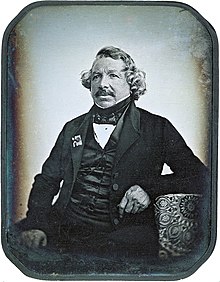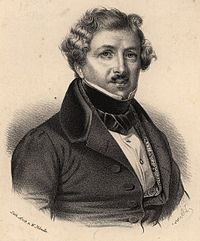Louis Daguerre: Difference between revisions
LeaveSleaves (talk | contribs) m Reverted edits by 209.68.139.250 to last version by Fieldday-sunday (HG) |
|||
| Line 10: | Line 10: | ||
'''Louis-Jacques-Mandé Daguerre''' ([[November 18]], [[1787]] – [[July 10]], [[1851]]) was a [[France|French]] artist and chemist, recognized for his invention of the [[daguerreotype]] process of [[photography]]. |
'''Louis-Jacques-Mandé Daguerre''' ([[November 18]], [[1787]] – [[July 10]], [[1851]]) was a [[France|French]] artist and chemist, recognized for his invention of the [[daguerreotype]] process of [[photography]]. |
||
== Biography == |
|||
FUCK |
|||
Daguerr was born in [[Cormeilles-en-Parisis]], [[Val-d'Oise]], [[France]]. He apprenticed in [[architecture]], theater design, and [[panoramic painting]]. Exceedingly adept at his skill for theatrical [[illusion]], he became a celebrated designer for the theater and later came to invent the [[Diorama]], which opened in [[Paris]] in July 1822. |
|||
In 1827, Joseph [[Nicéphore Niépce]] produced the world's first permanent photograph (known as a Heliograph). Daguerre partnered with Niépce two years later, beginning a four-year cooperation. Niépce died suddenly in 1833. The main reason for the "partnership", as far as Daguerre was concerned, was connected to his already famous dioramas. Niepce was a printer and his process was based on a faster way to produce printing plates. Daguerre thought that the process developed by Niepce could help speed up his diorama creation. |
|||
Daguerre announced the latest perfection of the [[Daguerreotype]], after years of experimentation, in 1839, with the [[French Academy of Sciences]] announcing the process on [[January 7]] of that year. Daguerre's [[patent]] was acquired by the French Government, and, on August 19, 1839, the French Government announced the invention was a gift "Free to the World." |
|||
Daguerre and Niépce's son obtained a pension from the Government in exchange for freely sharing the details of the process. |
|||
Daguerre died in [[Bry-sur-Marne]], 12 km from [[Paris]]. A monument marks his grave there. |
|||
[[Image:Louis Daguerre.jpg|thumb|left|200px|Louis-Jacques-Mandé Daguerre.]] |
|||
== Competition with Talbot == |
== Competition with Talbot == |
||
Revision as of 20:59, 25 September 2008
Louis Daguerre | |
|---|---|
 Louis-Jacques-Mandé Daguerre | |
| Born | November 18, 1787 |
| Died | July 10, 1851 |
Louis-Jacques-Mandé Daguerre (November 18, 1787 – July 10, 1851) was a French artist and chemist, recognized for his invention of the daguerreotype process of photography.
Biography
Daguerr was born in Cormeilles-en-Parisis, Val-d'Oise, France. He apprenticed in architecture, theater design, and panoramic painting. Exceedingly adept at his skill for theatrical illusion, he became a celebrated designer for the theater and later came to invent the Diorama, which opened in Paris in July 1822.
In 1827, Joseph Nicéphore Niépce produced the world's first permanent photograph (known as a Heliograph). Daguerre partnered with Niépce two years later, beginning a four-year cooperation. Niépce died suddenly in 1833. The main reason for the "partnership", as far as Daguerre was concerned, was connected to his already famous dioramas. Niepce was a printer and his process was based on a faster way to produce printing plates. Daguerre thought that the process developed by Niepce could help speed up his diorama creation.
Daguerre announced the latest perfection of the Daguerreotype, after years of experimentation, in 1839, with the French Academy of Sciences announcing the process on January 7 of that year. Daguerre's patent was acquired by the French Government, and, on August 19, 1839, the French Government announced the invention was a gift "Free to the World."
Daguerre and Niépce's son obtained a pension from the Government in exchange for freely sharing the details of the process. Daguerre died in Bry-sur-Marne, 12 km from Paris. A monument marks his grave there.

Competition with Talbot
The work on the Daguerre process was taking place at the same time as that of William Fox Talbot in England on the calotype process. Both men knew that they were working on a process that would revolutionize the art world. The Grand Tours which were so popular were illustrated by drawings of scenes and the "photographic" process would improve the quality and ease with which these popular holiday memories could be produced.
To protect his own invention, Daguerre himself registered the patent for Britain on August 12 (a week before France declared it "Free to the World"), and this greatly slowed the development of photography in that nation. Great Britain was to be the only place the patent was enforced. Antoine Claudet was one of the few people legally able to take daguerreotypes there.
Daguerre did not need to make money from the invention to live, since he had been pensioned by the French government[1]. Fox Talbot spent a considerable amount of money on his process (est. £5,000 in 1830s money) and licensed the process to British photographers where it was used instead of the Daguerreotype.
Development of the Daguerreotype

The first permanent photograph was made in 1826 by Joseph Nicéphore Niépce, building on a discovery by Johann Heinrich Schultz (1724): a silver and chalk mixture darkens under exposure to light. Niépce and Daguerre refined this process. Daguerre first exposed silver-coated copper plates to iodine, obtaining silver iodide. Then he exposed them to light for several minutes. Then he coated the plate with mercury vapor heated to 75° Celsius, to amalgamate the mercury with the silver, finally fixing the image in salt water. These ideas led to the famous Daguerreotype.
The resultant plate produced a mirror-like exact reproduction of the scene. The image was a mirror of the original scene. The image could only be viewed at an angle and needed protection from the air and fingerprints so was encased in a glass-fronted box.
Some ambrotypes were passed off as Daguerreotypes by being placed in these type of boxes. But the process was cheaper involving a weakly developed negative being placed on back card or paper to appear as a positive. Tintypes also were "boxed" as Daguerrotypes.
Daguerreotypes were usually portraits; the rarer views are much sought-after and are more expensive. The portrait process took several minutes and required the subjects to remain stock still. Samuel Morse was astonished to learn that Daguerrotypes of streets of Paris did not show any humans, until he realized that due to the long exposure times all moving objects became invisible. The time was later reduced with the "faster" lenses such as the Petzval's portrait lens, the first mathematically calculated lens.
The Daguerreotype was the Polaroid of the day, producing a single image which was not reproducible (unlike the Talbot process). Despite this drawback, millions of Daguerreotypes were produced. By 1851, the year of Daguerre's death, the Fox Talbot negative process was refined by the development of the wet collodion process, whereby a glass negative enabled a limitless number of sharp prints to be made. These developments made the Daguerreotype redundant and the process very soon disappeared.
See also
References
- ^ 'A State Pension for L. J. M. Daguerre for the secret of his Daguerreotype technique' by R. Derek Wood, Annals of Science, 1997, Vol 54, pp. 489-506), www.midley.co.uk/Pension/Pension.htm
- Carl Edwin Lindgren. Teaching Photography in the Indian School. Photo Trade Directory: 1991. India International Photographic Council. Edited: N. Sundarraj and K. Ponnuswamy. VII IIPC-SIPATA Intl. Workshop and Conference on Photography - Madras, p. 9.
External links
- Daguerre (1787–1851) and the Invention of Photography from the Metropolitan Museum of Art.
- Louis Daguerre (1787–1851) from World Wide Art Resources.
- Daguerre, Louis Jacques Mande by Robert Leggat.
- Daguerre and the daguerreotype An array of source texts from the Daguerreian Society web site
- Daguerre Memorial in Washington D.C.
- Louis Daguerre Encyclopedia Britannica
- the small lunar crater named after Louis Daguerre


